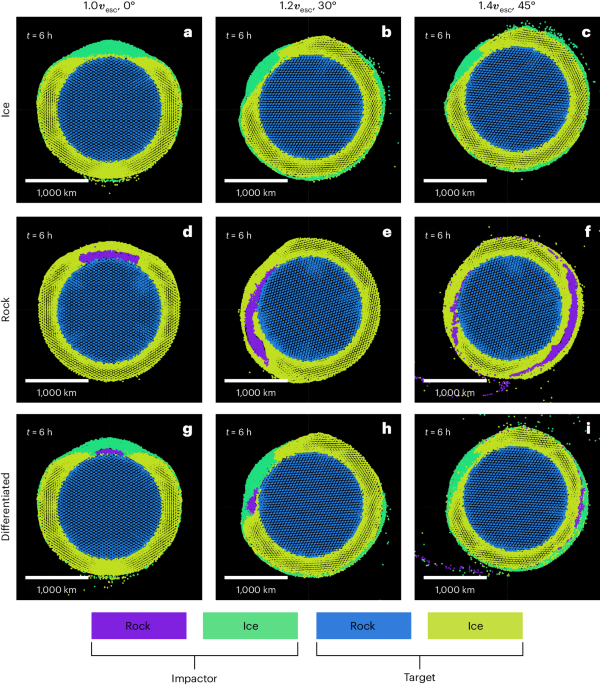The mystery of how Pluto acquired a giant heart-shaped feature on its surface has finally been solved by an international team of astrophysicists led by the University of Bern and members of the NCCR (National Center of Competence in Research) PlanetS.
The team is the first to successfully reproduce the unusual shape through numerical simulations, attributing it to a giant, slow oblique-angle impact.
Ever since the cameras of NASA's New Horizons mission discovered a large heart-shaped structure on the surface of the dwarf planet Pluto in 2015, this "heart" has intrigued scientists due to its unique shape, geological composition and elevation.
A team of scientists from the University of Bern, including several members of NCCR PlanetS, and the University of Arizona in Tucson used numerical simulations to investigate the origins of Sputnik Planitia, the teardrop-shaped western part of Pluto's heart-shaped surface.
According to their research, Pluto's early history was marked by a cataclysmic event that formed Sputnik Planitia: a collision with a planetary body about 700 km in diameter.
The team's findings, recently published in the journal Nature Astronomy, also suggest that Pluto's internal structure is different from what was previously assumed, indicating that there is no underground ocean.

A divided heart
The "heart", also known as Tombaugh Regio, captured the public's attention immediately after its discovery. But it also immediately captured the interest of scientists because it is covered in a high albedo material that reflects more light than its surroundings, creating its whiter color.
However, the "heart" is not composed of a single element. Sputnik Planitia (the western part) covers an area of 1200 by 2000 kilometers, which is equivalent to one-fourth of Europe or the United States. What is surprising, however, is that this region is three to four kilometers lower in elevation than most of Pluto's surface.
"Sputnik Planitia's bright appearance is due to the fact that it is predominantly filled with icy white nitrogen that moves and convects to constantly smooth the surface. This nitrogen probably accumulated quickly after the impact due to the lower altitude," explains Dr. Harry Ballantyne from the University of Bern, lead author of the study.
The eastern part of the "heart" is also covered by a similar but much thinner layer of icy nitrogen, the origin of which is still unclear to scientists, but is probably related to Sputnik Planitia.
An oblique impact
"Sputnik Planitia's elongated shape strongly suggests that the impact was not a direct frontal collision, but an oblique one," points out Dr. Martin Jutzi from the University of Bern, who initiated the study.
So the team, like several others around the world, used its SPH (Smoothed Particle Hydrodynamics) simulation software to digitally recreate such impacts, varying the composition of Pluto and the impacting object, as well as the speed and angle. These simulations confirmed scientists' suspicions about the oblique angle of the impact and determined the composition of the object.
"Pluto's core is so cold that the rocks remained very hard and did not melt despite the heat of the impact and, thanks to the angle and low speed, the core of the object did not sink into Pluto's core, but remained intact, like a stain, on it," explains Harry Ballantyne. "Somewhere underneath Sputnik is the remnant core of another massive body, which Pluto never got around to digesting," adds co-author Erik Asphaug from the University of Arizona.
This strength of the core and the relatively low speed were key to the success of these simulations: a lower force would result in a very symmetrical surface that doesn't look like the teardrop shape observed by New Horizons.
"We're used to thinking of planetary collisions as incredibly intense events in which you can ignore the details, except for things like energy, momentum and density. But in the distant Solar System, the speeds are much lower and the solid ice is strong, so we have to be much more precise in our calculations. That's where the fun begins," says Erik Asphaug.
The two teams have a long history of joint collaborations, exploring the idea of planetary "splashes" since 2011 to explain, for example, the characteristics of the hidden side of the Moon. After our Moon and Pluto, the University of Bern team plans to explore similar scenarios for other bodies in the outer Solar System, such as the Pluto-like dwarf planet Haumea.
There is no subsurface ocean on Pluto
The current study also sheds new light on Pluto's internal structure. In fact, it is much more likely that a giant impact like the one simulated occurred very early in Pluto's history.
However, this poses a problem: a giant depression like Sputnik Planitia is expected to move slowly towards the pole of the dwarf planet due to the laws of physics, since it has a mass deficit, but paradoxically, it is close to the equator.
The previous theoretical explanation was that Pluto, like several other planetary bodies in the outer Solar System, has a subsurface ocean of liquid water. According to this previous explanation, Pluto's icy crust would be thinnest in the Sputnik Planitia region, causing the ocean to swell there and, as liquid water is denser than ice, there would end up being a mass surplus that would induce migration towards the equator.
However, the new study offers an alternative perspective.
"In our simulations, Pluto's entire primordial mantle is excavated by the impact and, as material from the core of the impacting object 'splashes' Pluto's core, it creates a local mass surplus that can explain equatorward migration without a subsurface ocean or, at most, a very thin ocean," explains Martin Jutzi. Dr. Adeene Denton from the University of Arizona, also a co-author of the study, is currently carrying out a new research project to estimate the speed of this migration.
"This new and inventive origin for Pluto's heart-shaped feature could lead to a better understanding of the dwarf planet's origin," he concludes.





